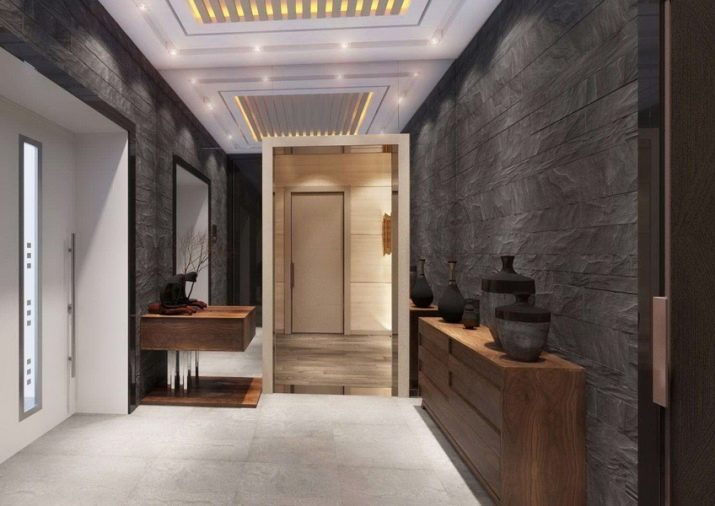Using laminate flooring for wall decoration in the hallway

The great popularity of laminate flooring can be explained very simply - it is a practical material that is sold in the widest range at affordable prices. Manufacturers produce collections that imitate the texture of ceramic tiles, natural wood, stone and even reptile skin. Thanks to this diversity laminate is widely used both for flooring and for decorating walls in the hallway.

Interior design features
Everyone knows that laminate flooring is commonly used for flooring in an apartment. However, the material can also be bought for vertical surfaces, this is not surprising:
- due to a wide variety of textures and colors, you can embody the most original ideas in the interior;
- laminate is considered one of the cheapest materials, so it is ideal if the homeowner plans to carry out repairs at minimal cost;
- high thermal insulation properties make it possible to use lamellas not only as a decorative coating, but also as an additional insulation;
- laying panels of the correct geometric shape allows you to save on installation - you can do the cladding with your own hands without the involvement of third-party specialists.


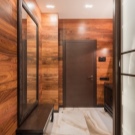

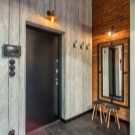

Advantages and disadvantages
Like any other finishing material, laminate flooring in the hallway has its own advantages and disadvantages.
The benefits of coating include a number of factors.
- Decorativeness - the laminate has an original texture that imitates natural materials. This gives the finish a peculiar charm and aesthetic appeal.
- Environmental friendliness - the coating does not contain harmful and toxic substances, therefore it is suitable for finishing residential premises.
- Durability - the wall covered with laminate keeps its appearance unchanged for many years. It is characterized by resistance to wear, abrasion, scratches and light mechanical damage that occur in hallways, especially when transporting new furniture and building materials.
- Soundproofing - a special technology for the production of laminate allows it to reduce the level of noise coming from the corridor to the room and muffle the overwhelming part of the outgoing one.






A pleasant bonus for everyone who decides to veneer the wall with laminate is the ease of maintenance of the coating. The material can be easily washed with plain water and soapy water, the only thing that is required from the owners is to wipe the lamellas dry.
This is especially important when it comes to the entrance area in an apartment or house. It is no secret that this particular room is subject to maximum pollution. Entering the hallway, we put dirty shoes against the walls, drops of water fall on them from clothes and umbrellas, and they are far from always clean; here, bags with groceries are leaning against the walls. And if four-legged pets live in the house, then after a walk in damp weather the problem of cleanliness in the corridor is doubly acute.


Not every coating can cope with such a load, so the laminate becomes the best choice in terms of price-quality ratio: the top of the material is covered with the thinnest film, thanks to which dirt and dust particles do not settle.
It should be noted that laminate is one of the rare finishing materials that are coated with special compounds that increase its fire resistance. It almost does not burn, and under the influence of high temperatures does not emit toxic substances - in this, the coating significantly outperforms wood and plastic panels.


However, there were some drawbacks.
- Despite the fact that the laminate is protected from moisture, nevertheless, you should not use it for cladding corridors in private houses, where residents enter the hallway directly from the street - under the influence of temperature changes, the material begins to deform. However, a good way out of this situation can be the installation of a thermal curtain, which will prevent the cold from entering the house and will help maintain a healthy microclimate. Thanks to this solution, it is possible to protect the coating and maintain its attractive appearance for a long time.
- In order to fix the laminate to the assembly glue, only a flat surface is required; there should be no bumps, slopes or other deformations on the walls.
- Unfortunately, laminate flooring cannot be called a thin material, therefore, after installation, the dimensions of the corridor are slightly reduced, this finishing material is not suitable for very tight spaces.




Color spectrum
To decide on the color palette of laminate wall decoration, you need to know the main particularities of this or that direction in the decor.
For classic interiors, preference should be given to light lamellas with a smooth surface., however, in this case, it is very important to complement the design half columns, mirrors and paintings.


For the design of modern high-tech and minimalism trends laminate is used infrequently, since paint or plaster is more in demand. However, some options involve the installation of lamellas, but only if the coating is made in light colors without a pronounced texture.


For country-style rooms you should choose a laminate that imitates the color of natural wood, while the shades of the panels used can be both light and dark - the main thing is that they are in harmony with the overall color scheme of the room.



In dark hallways, panels should be light, dark colors are allowed only in spacious rooms, and then only partially. In this color, you can decorate one wall, or combine a light top in a decor with a dark bottom.

How to choose a material?
The choice of material for wall decoration should be based on the characteristics of the decor of the room, as well as on what facing materials were taken for the floor and ceiling. With the help of laminated plates, you can effectively decorate the entrance area where households take off their shoes and outerwear - this is a moisture-resistant and easy-to-clean material, therefore it will be appropriate where the walls are especially prone to dirt.

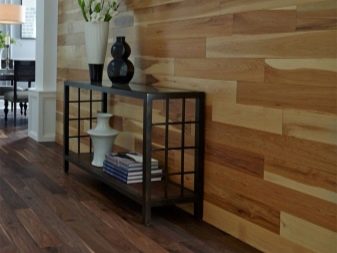


Laminate is harmoniously combined with rooms decorated in Provence and country style, if you prefer eco-style, then absolutely all vertical surfaces in the corridor can be finished with lamellas.


If you are looking for laminated panels for interiors in classic style, it is best to use one wall decorationMoreover, if the hallway is finished in a classic style, a laminate that imitates natural wood will look great.


If you are a supporter high-tech style - it is better to give preference to panels with a glossy surface, and for industrial decors it is better to opt for tiles, imitating timber.
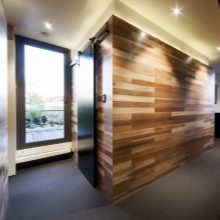


When choosing a laminate, it is necessary to determine in advance the load to which the panels will be subjected. In the case of wall decoration, this parameter is minimal, so the most budgetary option will be enough - it is allowed to use low-class panels, since there is no need for high wear resistance of the coating. Usually, the walls are decorated with panels of class 21-23 - in this case, the savings will be very significant.


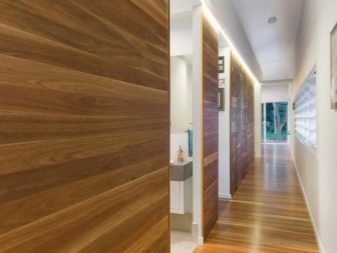

According to the installation method, the laminate is divided into several types.
- Glue - in this version, lock couplings are not provided. Laying is done on a leveled and carefully prepared surface using strong adhesives.


- Sheet piling - the strips are fixed in the groove of the tongue with small nails or staples, and the boards themselves are installed on the crate.


- Clicky - this method of fastening is considered the most reliable. When cladding the surface, the boards are inserted into a special groove and snapped into place, after which they are fixed on the crate with glue.


Keep in mind that click and tongue methods will hide the space, so they can only be installed in spacious hallways, and glued laminate requires walls without protrusions.
Placement methods
There are several methods for placing laminate flooring on corridor walls. Let's dwell on each of them in more detail.

Horizontally
By fixing the slabs parallel to the floor, it is possible to achieve a visual extension of the room and the expansion of its boundaries. Corridors decorated in this way become more spacious, light and airy, this solution looks especially impressive if it is enhanced with small inserts from tinted mirrors.


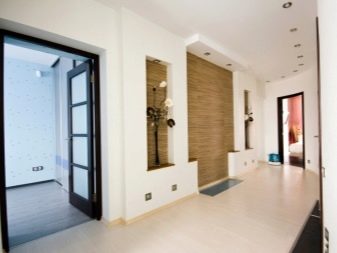

Traditionally, large lamellas are used for spacious rooms, narrow ones for small-sized ones, although in recent years there has been a departure from this tradition, and many designers take several huge laminate panels to decorate an 8-10-meter space.
The lamellas can be placed exactly one above the other, or they can be laid in an intricate mosaic - everything here depends only on your personal preferences and the stylistic solution of the decor as a whole. The panels can be the same, or have different lengths, but in any case, their thickness must be the same, otherwise the pattern will be displaced, and the design will lose its decorative effect.

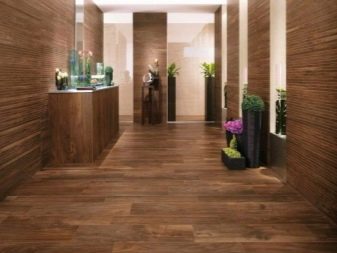


Vertically
The vertical fixation of the lamellas visually raises the ceiling, especially when the shade of the boards is combined with the finish of the floor. At the same time, the smaller the ornament on the slab, the more conceptual the whole room looks like. It is advisable to choose only one wall opposite the window for vertical design - sunlight will create stylish accents on it, make it much more catchy.
Vertically located lamellas are most often used for facing hallways - this room in typical high-rise buildings is small, and thanks to a simple technique, this defect is visually compensated.

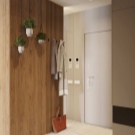




If you like unconventional solutions in the interior, then try to mount the laminate diagonally - this design looks harmonious both in large and small spaces, the main thing is that the slats have the same width.

Successful examples
If desired, you can always use the herringbone decor, however, you should be as careful as possible with this design, as it can give your space an old-fashioned look.


You can select a separate section of the wall with a laminate, or you can fill the whole room with it. A single composition looks spectacular, in which the floor and ceiling are finished with the same materials - such a solution visually erases the sharp boundaries in the room, fills the space with a feeling of warmth and family comfort.


Laminate can be used for wall decoration not only in the hallway.
For example, for a young man's apartment, you can arrange an asymmetric composition of lamellas, complementing it with stylish posters or car signs. Young people will surely like the bright decor, so you can paint the panels with paint in rich colors.

In romantic interiors pleasant smooth tones that will relax and help relieve nervous tension will be appropriate - nude, sandy, vanilla.

Various shades of gray are recommended for loft or industrial design, such decor will unobtrusively emphasize the style and at the same time soften it due to the pronounced texture.
